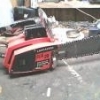

tackdriver56
-
Content Count
28 -
Joined
-
Last visited
Reputation Activity
-
 tackdriver56 got a reaction from Lee in O&R Engine rebuild pics
tackdriver56 got a reaction from Lee in O&R Engine rebuild pics
Oh! Thanks for the balloon test info.
Something else I found that I can warn about, is that when I removed the induction section to check the crankshaft seal,
I had to make a new gasket for the induction section. It was marginally thicker than the original.
Whether from the increased thickness, or lack of resilience of the old O-ring,
I needed to add TWO layers of the same gasket material between the o-ring and the induction hole, to seal around the
bolt.
-
 tackdriver56 got a reaction from Wallfish in Polaris Power Pole
tackdriver56 got a reaction from Wallfish in Polaris Power Pole
My PPP is now running, thanks to helpful advice from Wallfish. After changing the diaphragm, I still needed to disassemble the carb and clean the screen adjacent to the needle seat. One other major problem was an opening directly from the gear-case into the induction section, caused by a previous owner failing to install one of the screws. The shaft seal looked a little worn but it's serviceable. Gear oil now stays in the gear case, where it belongs!
I moved SNOW today!
-
 tackdriver56 reacted to Webhead in O&R Engine rebuild pics
tackdriver56 reacted to Webhead in O&R Engine rebuild pics
One of the first things that I do before putting an O&R engine back together after dismantling for cleaning and rebuilding, is to give it a leak down test to see if the seals are good and other areas of possible leakage. First, I leave the carb off. Install the spark plug and tighten. Make sure that the points push rod is in place, preferably with a little o ring lube. I then stretch a balloon over the exhaust, past the rivet on the neck. I found a plastic braided hose, about 4" long, that fits snug in to the carb inlet. I then blow in to the hose until the balloon is pretty full, remove my mouth and put my thumb over the hose inlet. Good seals allow the balloon to deflate at a very slow rate. A decent sized leak can actually be heard, hissing out of the bad seal on the flywheel side or the pto side. Other leaks can be at the spark plug or the push rod o ring. I had one that had hairline cracks in the crankcase and took multiple times to find. It appeared to be an engine that had never been ran and was bad from the factory casting.


